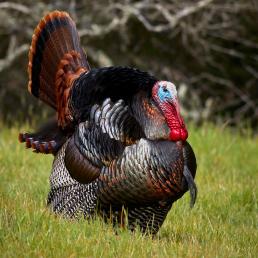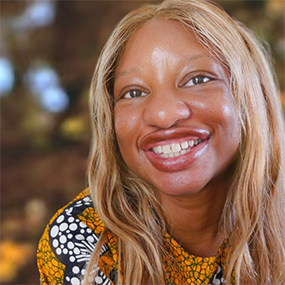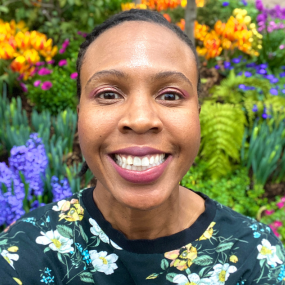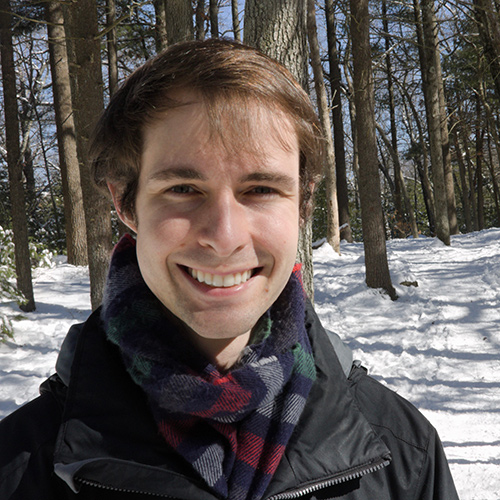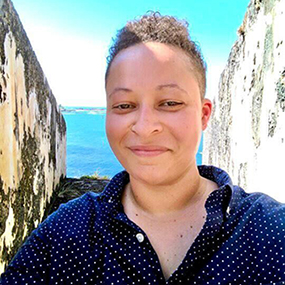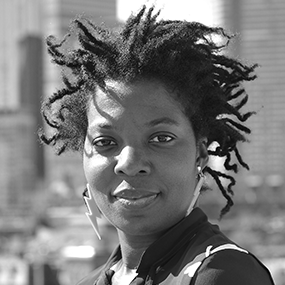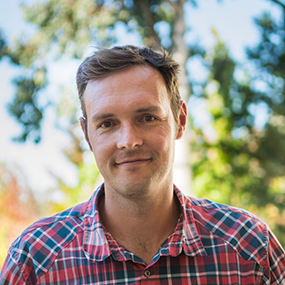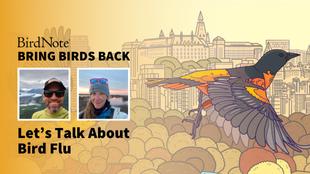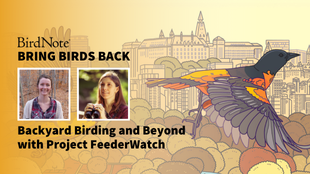

Join BirdNote tomorrow, November 30th!
Illustrator David Sibley and actor H. Jon Benjamin will face off in the bird illustration battle of the century during BirdNote's Year-end Celebration and Auction!
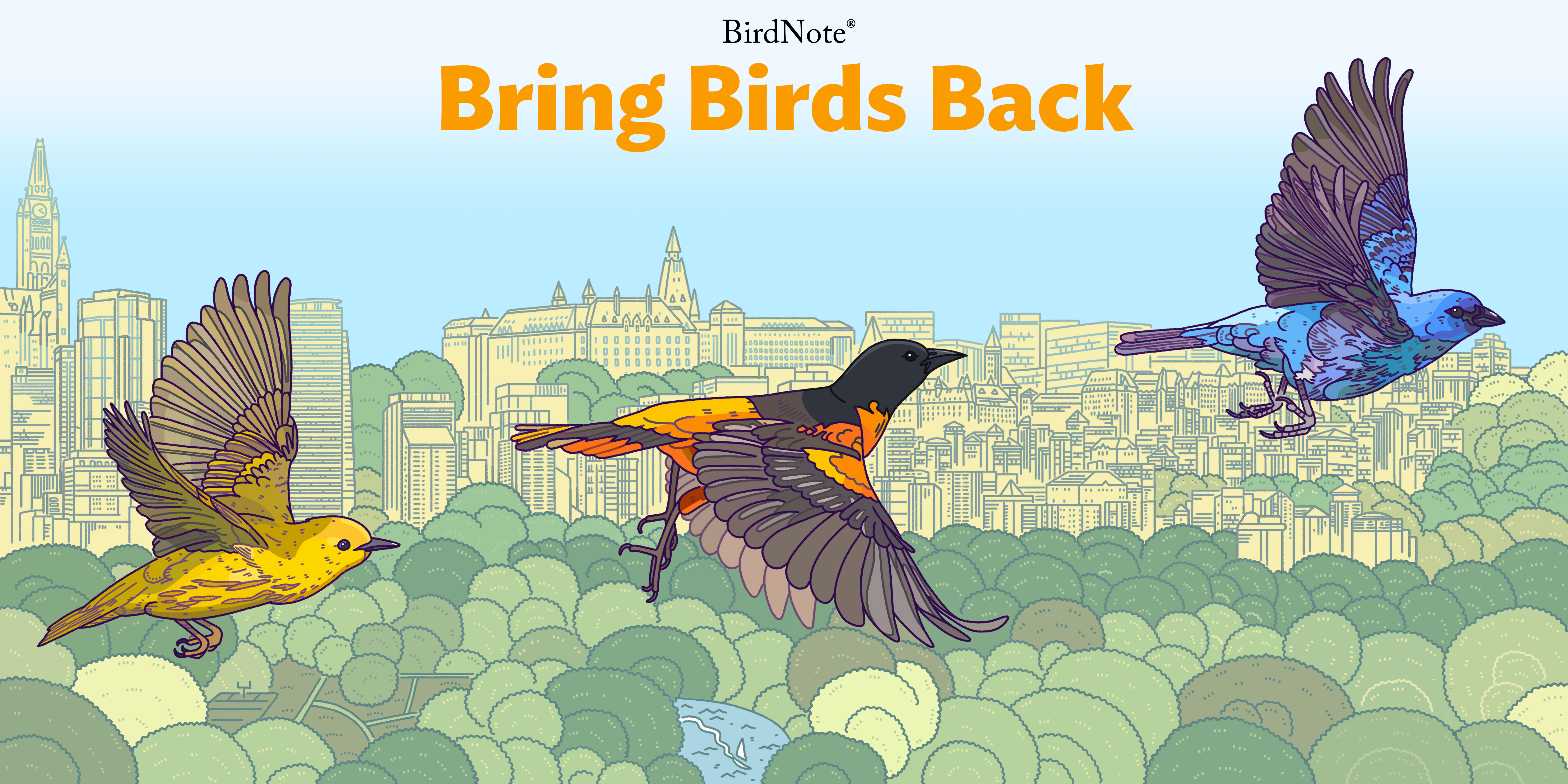
In this special episode, we explore the critical effects of noise pollution on both humans and birds. Dr. Erica Walker offers an insightful view of how people are negatively impacted by loud disturbances, from everyday life to health complications. And Dr. Clinton Francis shares his discoveries about the impact of noise on bird health and reproduction, from abandoning their habitats to doubling their fertilization rate. Co-produced by our guest host, Tasha Lawson. Press play!
For more information about the From Love to Action campaign, episode transcript and other resources from this episode, visit BirdNote.org.
Want more Bring Birds Back? Subscribe to our show and follow us on Instagram! For more about BirdNote, sign up for our weekly newsletter. And for ad-free listening and other perks, sign up for BirdNote+ here.
BirdNote is a nonprofit. Your tax-deductible gift makes these shows possible.
Bring Birds Back Special Season 5 is sponsored by the Cornell Lab of Ornithology.
Jazzi Johnson: Hey, bird lovers,
I’m Jazzi Johnson, Managing Editor at BirdNote. We’re excited to bring you this new season — but before we do, I want to tell you about BirdNote’s From Love to Action campaign to mobilize a million people to help the environment.
Here at BirdNote, we believe that when we love something, we have to protect it. That’s why we share stories about the world of birds with millions of radio and podcast listeners across the globe.
But habitat loss, pollution, climate change and more are threatening the lives of birds — and these threats aren’t only significant for our flying friends, they’re also significant for us — all of us. So, it’s crucial that we do more than just tell you about what’s happening to our planet — we must also show up with intention and set an example with our actions.
That’s why we’re on a mission to inspire and empower our audience to translate the love for birds into action for Earth — and all of its inhabitants. And we’re asking you to join us.
In this special season of Bring Birds Back, we’re putting the spotlight on just a few of the most overlooked and lesser known threats to our planet. And it’s our hope that this knowledge will not only inform you, but propel you to act.
Learn more about the From Love to Action campaign when you visit Bird Note dot org.
Tasha Lawson: BirdNote Presents
[Bring Birds Back Stinger]
From BirdNote, this is Bring Birds Back. I’m your guest host Tasha Lawson, a nature lover and birder who leads nature outings for historically excluded communities in the Chicago area.
[Puzzling Music Starts]
In March of 2020, we experienced an unprecedented time of solitude and community with a call for justice and a need for healing.
Like many, I was furloughed from my job, so I took refuge in nature. And for the first time, I explored new areas I’d previously neglected and rediscovered some trails…
[Sounds of large group of Sandhill Cranes begins fading into the background]
…like, a nearby meadow at a busy intersection, where hundreds of Sandhill Cranes flew overhead, hovered overground and encapsulated me with their undulating calls. It was an all consuming experience. I wondered: Did they always do this here? Or, did the lockdown create more space for them?
Similar firsts included seeing weasels and hearing the haunting howls of a coyote pack.
[Coyote pack howling]
I even spotted several lifers from my watch list, like Cape May Warblers, Rusty Blackbirds and a Black-bellied Plover.
[Black-bellied Plover Call]
And it was quiet. Like, ‘sigh of relief’ quiet. A welcome reprieve from the constant helicopters and sirens near my house. Physical symptoms of stress even disappeared. Nature became a way through tragedy and towards joy, especially for those who’ve been unjustly excluded from the outdoors.
But, as businesses reopened, daily sounds of traffic and planes returned. And suddenly, I was so much more aware of the constant noise that polluted the space around me.
According to research published in the journal Science, background noise in some urban areas fell as much as 50% during COVID lockdown– the quietest period ever documented on Earth.
Noise ranks second only to air pollution as the environmental exposure most harmful to public health. Noise pollution is defined as any distressing or undesirable sound that affects the health of living beings like humans, animals, and even plants.
In the U.S., awareness around this issue ramped up with the Noise Control Act of 1972, led by the Environmental Protection Agency. However in 1981, federal funding was terminated for these projects and has yet to be revived.
But there’s still so much to be learned about the effects of noise pollution on humans and wildlife today. On this special episode of Bring Birds Back, I talk with two noise experts: Dr. Clinton Francis, who has dedicated his work to researching the relationship between birds and noise.
And Dr. Erica Walker, who we’ll talk with first, about her work exposing noise pollution as an environmental justice issue.
[Music ends]
Can you please introduce yourself and the work that you do?
Erica Walker: Yes, I'm Erica Walker. I'm the RGSS Assistant Professor of Epidemiology And I also am the founder of Community Noise Lab, which is also at Brown University School of Public Health.
Tasha Lawson: Got it. Thank you.
Okay. So when I was learning about the health effects of noise pollution, I was surprised at how much it's affecting us. But then, like, it all kind of made sense when I started learning more. So let's start with the basics for everybody. How does noise pollution affect people?
Erica Walker: Oof, many ways. So let's kind of break it down. So, you know, if we're somewhere where the sound is so loud, It could damage our ears and kill out our hearing. That usually happens in an occupational setting or just people who work around high or loud noise exposures.
Barring that, there are two other pathways that noise can impact our health. First is the disruption of the quality and quantity of sleep that you get each night. And we know that sleep is the time that our body tries to go back to achieve homeostasis balance, but if that is hindered, there can be just a stress response, right?
That constant stimulation of that stress response over a period of time, can lead to the manifestation of risk factors that lead to the manifestation of significant diseases ranging from hypertension, cardiovascular related mortality, ischemic heart disease, the list goes on.
But then, when we also think about noise, especially community noise, being something that you can't control. You can think of the mental health aspects of that as well. If you're personally feeling like you're under attack, under assault with these sounds, that can lead to anxiety, depression, et cetera.
Tasha Lawson: Wow. Thank you for that. And I had read somewhere diabetes, is that something that comes up?
Erica Walker: Yeah. I mean, because of that stress. There's an inflammation response. Yes, all of that. I've also heard dementia too, which is an, which is an interesting one.
Tasha Lawson: We may not think about it often, but if people can get stressed out and physically harmed by noise, then animals, like say: birds, can too.
Clinton Francis: There has been a rapidly growing literature showing that there are lots and lots of consequences of noise pollution for birds.
Tasha Lawson: That’s Dr. Clinton Francis, Associate Professor in the Biological Sciences Department at Cal Poly State University.
He says even birds deal with physiological challenges due to noise pollution, from lack of sleep to immune dysregulation over time. Some of which leads to forced displacement.
Clinton Francis: We know that noise pollution can displace birds from otherwise good habitat. I even think that reducing sound levels might be a key aspect for boosting urban avian diversity.
Tasha Lawson: Clinton is a sensory ecologist, which basically means he studies the way organisms acquire, process and respond to stimuli in their environment. These include human-made changes in the environment too, like noise pollution, of course, and he specializes in its effects on birds...
Clinton Francis: I was hired to work on a project trying to understand how birds’ reproductive success changed in response to noise from oil and gas activities. And as soon as I got into the literature, I realized there was hardly anything known about how birds respond to noise. In many ways, I saw it as a niche for me to keep pursuing, and I've been hooked ever since.
Tasha Lawson: Wow. Um, can you give some examples of how much birds rely on sound?
Clinton Francis: One thing that everybody might be really surprised about, is that, even though birds do rely on acoustics and hearing quite strongly, your typical bird hears about half as well as we do, and the example that I like to use with my students is if I'm standing in a room and I can barely hear a sound, it's just barely detectable to me in the corner of that room, a bird would have to be half the distance to it to be able to pick up that sound. So just because they can't hear as well as us doesn't mean that it's not an important sensory modality, right? And of course, there's also exceptions. There's acoustic specialists like owls who can hear much better than us.
Tasha Lawson: Right. Just learning that birds don't have the best hearing despite the fact that they're known for singing and they rely on sound so much. It's very ironic and you wouldn't intuitively think about that.
Clinton Francis: Yeah, so, many listeners probably think of birds really relying heavily on sounds. For example, males singing to attract mates or to defend territories from rivals or even to communicate with their offspring. But you know, birds rely on sounds for a lot of other aspects of their daily lives.
Many use passive listening to listen for threats like the sound of an approaching predator, or even listening for prey. Many people have seen birds doing this and probably don't know that it's happening. For example, American Robins, you might have an image of an American robin in your mind running across a grassy field and then tilting its head down to the grass. So they're not looking for worms, they're actually listening for worms rustling, or moving around just below the soil surface. And then they plunge their bill in and pull that worm out. Woodpeckers will listen to the surface of a tree for insects making scratching noises on the inside. And that's where they know to plunge their bill in to get at their food.
There's probably a lot of other examples out there, and people just haven't studied it, because we often don't think of birds using sound for hunting.
Tasha Lawson: So considering all the different ways birds rely on sound, how is noise pollution affecting them?
Clinton Francis: As they hear less well with increases in noise, they start using vision. So they start scanning. They pick up their head and start scanning. And this comes at a trade off of feeding or foraging, which is key to survival and reproduction. We also know that noise can shorten and fragment sleep, and there's all kinds of physiological changes in stress hormones, or even immune function when exposed to noise. And all of these changes, ultimately, point to, you know, some pretty dire consequences for birds exposed to noise.
In many landscapes, we know that noise essentially causes a decline in reproductive success for most birds. But, you know, it also works in some other strange ways. In some landscapes where their key nest predators are sensitive to noise, those that can tolerate nesting in noisy conditions actually have increased reproductive success because their main predators are gone.
Think of it as noise is a nest predator shield.
Tasha Lawson: Wow. So, those birds are adapting and benefiting in terms of reproduction. You mentioned some birds who aren't benefiting. What happens to their reproduction? And do you have any species examples of that?
Clinton Francis: Yeah, we know that some of the species that we've studied well that have the declines in reproduction are species like the Western Bluebird. We know that noise causes a decline in their reproductive success. And in our long term field sites in New Mexico, we also know that this decline in reproductive success is linked to that stress hormone dysregulation. A lot of times we think animals encounter stressful situations and their stress hormones go up, but in this particular case, their stress hormones go down and it's just a way that the body tries to protect itself from the deleterious consequences of having elevated stress levels due to these challenging conditions.
Tasha Lawson: So the increased noise is causing stress issues, which is limiting reproduction in these birds.
Clinton Francis: That's right.
[Puzzling, upbeat music starts]
Tasha Lawson: So, how did we get here? As Dr. Erica Walker tells us, cities were never truly blissfully quiet…
Erica Walker: So, I was reading a book at the time I started doing my noise research And I just remember an author that was describing the sounds in Philadelphia.
This was back in the, like, maybe late 1700s, early 1800s. And even then he was describing a very loud place. The clicking on the cobblestone of the horses, the church bells, people screaming out on the streets. And so the book started with that and then it sort of moved us through the history.
So, I think there's always been some types of sounds in our environment that have always created some sort of mood disruption.
Tasha Lawson: But with the industrial revolution, that noise expanded drastically. The 20th Century is documented as the noisiest century so far, resulting in the greatest loss of natural quiet in the history of the world.
Noise pollution wasn’t really a public policy topic until the 1970s when the national Office of Noise Abatement and Control was created. However, in recent decades, it’s slowly vanished from public conversation - along with the government’s attention.
Today, there’s a pretty clear leader in noise pollution— and it isn’t horses clicking down cobblestone anymore.
Clinton Francis: Well, people have studied a variety of sounds, but the leading one is really the sounds from our transportation, from roadway networks, or even aircraft. There is a recent study out of Colorado State and the National Parks, Natural Sounds and Night Skies Division showing that even overflights of 30,000 feet disrupt the behavior of birds.
It essentially stops their singing and you wouldn't think that these overpasses that are happening pretty infrequently and so far away would even change the behavior.
But there are other important sounds that cause changes in behavior. There's a lot of industry types of sounds out there from resource extraction, natural gas and oil. There's also sounds from recreationists moving across the landscape, causing what we typically think of as really pristine areas of then being dominated by human made sounds.
Or even in neighborhoods, leaf blowers are a huge source of noise pollution, especially at times that are critical for communication for songbirds. A lot of folks are out using their leaf blowers really early in the morning, and this tends to be the same time that birds are communicating with one another during dawn chorus.
Tasha Lawson: Wow. Leaf blowers.
[Music ends]
Erica Walker: Even myself growing up in a neighborhood, you may have heard loud sounds, but they were sort of distant, but now we do a lot of it ourselves, I mean, we just have a lot of stuff in our lives that is just unnecessarily loud.
Our phones, our TVs, people have cars, we have planes, we have trains. So we have made, or we've decided to make a sacrifice for convenience and entertainment to engage in things that are loud.
But at the same time, let's not neglect to pay homage to the extremely horrible urban planning of our cities. I mean, we've decided to intersect whole neighborhoods with highways, or we've decided to put poor communities under flight paths, or put them near industrial facilities.
So, you know, I'm not going to blame it all on us and say, like, we did this. A lot of us, because of our socioeconomic status or skin color, we are forced to live in certain areas of our city, and those certain areas of our city are usually poorly planned.
Tasha Lawson: I know you did a lot of work and studies from Tufts to Harvard to the Greater Boston Noise Report. So we're going to get into it. First, from your time at Tufts University studying the relationship between traffic noise and cardiovascular health in the community right next to a busy freeway. Can you tell us about this and what you learned?
Erica Walker: Yes, I went from trying to get my upstairs neighbors who are very loud, evicted, to like, actually trying to do a serious noise study. But at that time, there was a study at Tufts University called the CAFEH study.
I'm really bad with acronyms, but it was like communities that live near freeways. And I'm like, ‘Hey, you know, communities near freeways are very loud.’
But it wasn't until I made my first trip out there that I realized that there were just so many other factors that I wasn't considering. Of course, there was the highways, but then the road quality. So, that community had a patch of potholes and then everything was just like, “boom, boom, boom,” every time something drove over it.
And then I didn't realize that this community was under a flight path. So when I actually went out and visited the community, I realized that it was much more complex. And so that just kind of taught me the biggest lesson in knowing the place that you're studying before you actually get out there and study it.
Tasha Lawson: Wow. So, you also created our country's very first noise report card in 2016 through the Greater Boston Noise Report. So we'd love to hear about that project.
Erica Walker: Yeah, that was a great experience. So, okay, I learned from my Tufts experience, entered into a PhD program, was out there measuring sound levels, but then also because you're being out in the community, people coming up and talking to you and asking you like, what are you doing? Why are you in our neighborhood at like, 3:30 in the morning? And then having these kinds of conversations that gave me insight into the things that I was missing. I realized that there was a system of accountability.
There are people that now are very interested and want follow-up: Okay, you are measuring outside of my house, how loud is it? What's going on? And at that time too, I was going through an existential crisis about how we measure sound in our country. Like I was just realizing that the way we were doing it, it just didn't suit me and what I was observing on the ground.
So I thought that a report card would be a conversation grabbing way to describe the community soundscape, looking at more than just decibel levels. So in our report card, we graded communities on things that created noise, like the percentage of that community that's devoted to commercial districts, industrial districts, busy roads, but also things that mitigate sound. So, like more greenery, more bike paths. I just wanted to create an example of how we should be assessing our community soundscape.
[Transitional music starts]
Tasha Lawson: When we return, Erica explains how her noise work ignited her devotion to environmental justice; Clinton shares more information he uncovered through his studies about birds and pollution; and you’ll learn ways you can help your own neighborhood combat noise pollution – starting with your phone. Be right back.
MIDROLL
Tasha Lawson: And we’re back, here with Dr. Erica Walker.
You're the founder of Community Noise Lab at Brown University School of Public Health. I've never heard of a noise lab before learning about you and your work. I'd love to know how the noise lab came about.
Erica Walker: Yeah, so, after graduating with my doctorate, I realized that I was still sort of focusing on community noise from a researcher perspective, even though I was engaging communities and trying to propose new ways of doing things.
But with Community Noise Lab, I wanted to do something very different. I wanted to do what I call ride-sharing science. And I think if any of you guys have ever been in a Lyft, and when you share the ride with someone, you may go places or see things that you would not have experienced had you just said, I'm going to this location.
So with Community Noise Lab, in its first iteration, we just opened our doors up to communities that were dealing with noise issues, and we just tried to support them in the best way that we could.
And I learned so much and worked on so many fascinating projects. It just kind of blew my mind.
Tasha Lawson: What do you and your team research there with the community involved?
Erica Walker: So they usually set the topic and we've done everything from a baseball stadium that was repurposed into a live concert venue during the summer. We've done firework activity. We've done a community that was trying to argue for a sound wall that was next to this insane, crazy eight loop of interstate, a community that's dealing with tourism. So during the off season, it's perfectly quiet, but during the on season, it is like inundated with tourists.
I mean, you name it, we've done it. So they usually set the agenda, but what we do is we create an exposure assessment. We go out and measure the sound. We survey the community. And then we sort of create a series of reports or products that speak to their advocacy agenda.
Tasha Lawson: While Erica’s research helps to identify ways to better the lives of humans impacted by noise, Clinton’s work helps to identify just how harmful these human-induced noises are for our environment, including the fact that some birds are now laying fewer eggs because of it.
Clinton Francis: We've done some studies that suggest that birds that live in forested environments tend to be more sensitive to noise pollution than are birds that live in more open environments. And so we've done some really big comparative studies from great resources like the NestWatch program at Cornell Lab of Ornithology, where we analyzed over 58000 nest records and found that with increases in noise exposure, birds in forested environments tend to lay fewer eggs. And they also tend to have more nests fail in general.
And it often is because the chicks fail to hatch, so the eggs never hatch, so it never gets past that first stage of the nesting process, where you think about incubation of eggs and then rearing of nestlings.
Tasha Lawson: And that was where you studied the citizen science data for 142 species, and you paired it with noise data across the U. S.?
Clinton Francis: Yeah, we did. There's this really interesting resource that the National Park Service Division of Natural Sounds and Night Skies created this nationwide noise map, and so we were able to use that really unique resource and pair it with all of these nest observations that, you know, thousands of citizens have made all across the country.
Tasha Lawson: Wow. Go citizen science. So, I'm curious as to what birds did before this big increase in human noise.
Clinton Francis: Yeah, that's a really great question. A close collaborator of mine, uh, Dr. Jesse Barber at Boise State, he and I started wondering about this when we just started seeing this growing literature of all these responses to human-made sound. And so we thought, if there's all of these responses, these changes certainly don't come out of nowhere, right?
And so we started thinking about how noisy particular parts of the world can be. Coastlines with crashing surf, the sounds of river rapids, or even animal choruses. Chorusing insects or chorusing frogs can also be really, really loud and create very difficult listening conditions, right?
[The sounds of a choppy, churning river fade in]
And so what we did is, we set up an experiment that we called the Phantom Oceans and Phantom Surf.
And so we placed all of these speakers in areas where there was not rushing rivers, so there might be a small trickle of a stream, or shrub environments that were not immediately adjacent to the ocean. And we played back the sounds of oceans and the sounds of rivers in these areas.
And what we saw is we can essentially see many of the same types of responses that have been documented in response to human sounds. So we see the displacement of birds, birds with low frequency vocalizations tend to be more sensitive to these sounds. That's because ocean noise, river noise, or even human made noise has the most energy at really low frequencies, and so those birds with those really deep voices, their songs are masked or covered up more so than birds with your very high pitched songs.
[River sounds fade out]
But we also saw large scale changes in behavior, foraging behavior, territorial behavior, or even how these birds change their song in response to these natural sources.
Tasha Lawson: So, you discovered that birds have been doing this forever, just adjusting basically?
Clinton Francis: Yeah, that's true, but you have to think about the spatial extent of natural variation in noise. And even areas that we think of as noisy, they may not be noisy all the time.
[Gentle music starts]
You may have snow melt causing really loud riparian habitats, but then later in the season or before the snow melts, it can be quite quiet. So the challenge is, you know, a lot of these places are pretty limited in terms of the scope of the natural sounds.
What we're doing is we're making all the places that are typically quiet, they're now loud because of human activities.
Tasha Lawson: So you talked about birds singing at different frequencies. How have you seen that play out with human noise coming into play?
Clinton Francis: Some of the most well documented ways in which birds are changing their communication is, one, they will just sing more loudly. This is called the Lombard effect, and we do this too. We also know that a lot of different mammals do it. Some frogs will do it as well. And it's basically just increasing the amplitude or the loudness of our voice when we're trying to communicate in difficult conditions when it's noisy.
Another response that's really widespread is birds actually pitch their song to a higher frequency. So, a slightly higher song provides some relief for the birds to essentially sing above the low frequency noise and allows the active space or the distance at which that song can be heard by another individual by several meters.
Tasha Lawson: Wow. Are there some bird species that are better at this or adjusting better than others?
Clinton Francis: There was a very clever study several years ago out of a group in Germany in Henrik Brumm’s lab where they even played back noise to Tinamous, which represent one of the oldest clades of extant birds.
[Elegant-crested Tinamou song]
And even Tinamous will shift their vocalizations such that they're louder. They do the Lombard effect too. So we might expect that, you know, that's an ancestral state to all birds. Any bird confronted with noise will probably get louder when they're trying to communicate.
[Elegant-crested Tinamou song]
[Gentle music fades out]
Tasha Lawson: For an environmental issue like noise pollution, it can be difficult to know exactly how to help or resolve it. But the research that both Clinton and Erica are doing is key to turning the tide.
One method of tackling this issue is through direct exposure. For this purpose, Erica expanded Brown’s noise lab to her very own hometown in Jackson, Mississippi.
But it wasn't easy and it came with many lessons learned. Like how building community begins with prioritizing everyone’s concerns in her work.
Erica Walker: Yeah. So I'm born and raised in Jackson, Mississippi. And, you know, originally when I got to Mississippi and had my first community meeting, people were like, we ain't interested in noise. Uh, we have a water crisis. So, what can we do about the water crisis? And when you go into a community and listen to the needs, even if they're in direct opposition to what you were funded to do and what your expertise is, it builds a level of trust and respect.
Because of that now I'm able to say, oh, okay, we've tested your tap water, but can we put a sound sensor out in front of your yard? We're just curious. And so, you know, now we're putting up sensors across greater Jackson and in other areas and we’re doing hearing screenings. People are now beginning to kind of see how it's all connected, like how it's in our environments, but also impacting our health.
Tasha Lawson: So you're talking about other types of pollution in an area, like water pollution, air pollution, and how you've seen noise pollution as a barometer for that. So can you tell us more about that and why environmental justice is important in the noise pollution conversation?
Erica Walker: Because certain places just have certain sounds, and certain sounds are just related to all kinds of other environmental activity that is injurious to our health. And for me, it's like, I can't just do noise, right? I want to understand these other things and how they interact with each other. But, you know, like, without fail, even in rural communities, when you go to certain areas, whether it's in an urban city or in a small country town, they sound alike and they sound louder than more privileged spaces, even if it's in a rural area.
Like, we're working in a couple of communities now in Mississippi that, population 935 — it rivals where I live, and I live next to a freeway, and so it's just like, how did that happen? And then when you sort of do the bird's eye view of the community, it's like, oh yeah, there's an industrial plant smack dab in the middle of town, and they have 24/7 big trucks coming through the community to drop off and take away goods. Oh, and they did this because these communities are predominantly Black or poor.
Tasha Lawson: Wow, you know, in research, we found communities of color more likely to experience distractive noise levels because they're systematically subjected to fewer housing options, more likely to live near, you know, high traffic roads, waste dumps, industrial areas.
Erica Walker: And that is because we have planned our cities in such an insidious way that we have systematically decided that we're going to put all of the acoustical trash in certain communities and protect the peace and quiet of other communities.
Tasha Lawson: So, can you talk about efforts there have been or things that are being championed now just to address noise pollution as a whole?
Erica Walker: Yes. I'm just going to say we're doing nothing. I think we're saying that because we're collecting more data, we'll have more information, but that's not doing anything to do anything.
We're still listening to privileged voices, and we're still doing things that are just a band aid, for a very deep issue. So I don't know if you've heard about things like noise cameras in communities, I think that's one thing which I am completely 100 percent against.
Tasha Lawson: And for people who don't know, what is a noise camera?
Erica Walker: So it's essentially just a system that is like these sensors in communities and if someone drives with a loud car, it'll take a snapshot of the license plate and send that person a ticket.
Tasha Lawson: For the sound, for the noise.
Erica Walker: Essentially, for violating an unknown level that they've gone over.
Tasha Lawson: It's giving ‘get off my lawn’.
Erica Walker: Oh, it's giving, it's giving more than that. It’s giving over-policing, it's giving targeting, it's giving we want to validate negative stereotypes about certain communities.
We're still engaging with the wrong people who have very superficial knowledge of the noise issues in our country, and they are the ones proposing these very superficial solutions that are not going to do anything to address the noise issues systemically and equitably.
[Reflective music starts]
Tasha Lawson: So what are some ways right now, today, someone can begin reducing the effects of noise pollution for their health, if this is their current reality?
Erica Walker: I mean, I can give you a list of earplugs and acoustical curtains and they call them masking machines. So you can sort of put out into the air white noise, pink noise, brown noise, to sort of mitigate some of those sounds.
I can tell you to meditate. But for me I think the first line of defense is to actually fight for peace in your community. Because no one is going to be like, oh, look at that community over there. Usually people don't care. I think it's time to advocate for change.
So I would encourage people to fight.
Tasha: What are some good first steps to fighting for the peace?
Erica Walker: Contact myself or people who are dedicated to gathering objective data to describe the problem and willing to put it all on the line for the communities.
There's going to be a point where there's going to be that straw that breaks the camel's back.
Start by collecting objective data and using that objective data to make a lot of noise.
Tasha Lawson: One simple way to start? Measure the noise pollution surrounding you by using NoiseScore, a free app Erica and her team created that allows you to determine and document the noise levels of your neighborhood or anywhere you so choose– and how you feel when you hear it.
Just as sound pollution and environmental justice affect human populations when exposed over lengths of time, we must also consider how constant disruption due to environmental changes impact wildlife in the long run.
So, is there a ticking clock on this issue for birds? Like, is there a point in time where there’ll be so much noise that animals and birds will no longer be able to effectively communicate?
Clinton Francis: There's certainly areas where that is true already, and it really just depends on the species.
Tasha Lawson: Dr. Clinton Francis.
Clinton Francis: But we can see this in lots of different studies where we see complete avoidance of some species from very noisy environments. So there’s no type of behavioral adjustment will work for them to, you know, cope with those difficult listening or communicating conditions.
In our long term study sites in New Mexico, where we've studied how noise from, essentially the energy sector, restructures bird communities, we see a complete loss of about one third of species in noise polluted areas compared to comparable quiet areas.
And some experimental studies that have broadcast the sounds of roads in areas where birds migrate see the same type of thing, a complete loss of about one third of the species. So, that's a big change in the number of species that really can't handle any kind of increase in sound levels due to human activities.
Tasha Lawson: Oh, my goodness. So, aside from making people more aware of the harms that come from noise pollution, do you have any suggestions for how people can help reduce noise for both birds and themselves?
Clinton Francis: Sure. You're identifying a really tricky scenario: we don't hear even the, the few birds that we might be able to hear otherwise on our daily commute because we listen to headphones or earbuds all the time.
But there are lots of things that we can do.
Tasha Lawson: Some suggestions that Clinton offered are: switching to electric vehicles and even low-noise tires, which reduces friction between the wheels and the roadway, resulting in less noisy cars; using lawn care equipment at times of day when birds aren’t singing or that doesn’t produce much sound.
Clinton Francis: Maybe don't use them at all and use a rake instead.
Tasha Lawson: Only listening to music through headphones when hiking in national parks and protected areas.
Clinton Francis: I think there's just a lack of awareness that that sound, well, can really disrupt the animals in the surrounding vicinity.
Tasha Lawson: And in addition to participating in community science projects such as NestWatch or Project Feederwatch, Clinton encourages contacting your local representatives to take action.
Clinton Francis: There's also really important ways in which citizens can engage with their local government about noise issues. And this is important because there's both wildlife issues at stake and also human health. Things like reducing speed limits or even incentivizing green transportation alternatives, bike infrastructure, electric bike infrastructure can go a long way in reducing sound levels, especially if you get a city on board to make those changes.
[Music ends]
Tasha Lawson: While we primarily focused on humans and birds in this episode, the issue of noise pollution is detrimental to many living organisms on Earth, as sound is used to navigate habitat, locate food, attract mates, and avoid predators. Even marine mammals like whales and dolphins that rely on echolocation are experiencing repercussions caused by noise from ships, oil drills, sonar devices, and seismic tests in oceans.
Like many environmental concerns, sound pollution is compounded by environmental racism and income inequality. And while awareness of how sound affects us and the planet is low, we can help amplify and increase its visibility together.
[Outro music starts]
We may live in a modern society, but nobody needs their life cut short because of traffic noise. That math just isn’t mathing.
And to be clear– we’re not advocating for a quiet society– we experience so much joy from sound - from turning up our favorite music, to celebrating in large gatherings, and even listening to birdsong– (check out Season 3, Episode 6’ if you don’t believe me!)
However, before our new world came about, there used to be more space for reprieve from excessive noise, and now more than ever, it’s time we try to get some of that old thing back. So, here’s to spreading awareness, offering hope, and lending our ears to causes that will help us all have longer, healthier, better quality lives.
[Music break]
BirdNote is on a mission to inspire a million people to take action to help birds and our environment – over the next three years. And in this special season of Bring Birds Back, our goal is to show you that every little action for you, is an even greater action for our beloved birds.
To find more resources about noise pollution, learn about our guests and ways you can take action with us, visit our website, BirdNote.org.
And follow us at Bring Birds Back on Instagram for the latest updates about the show.
Bring Birds Back is created by our producers, Mark Bramhill and Sam Johnson. Managing Editor is Jazzi Johnson; Fact-checker, Conor Gearin; and Content Director is Jonese Franklin. Music is by Cosmo Sheldrake and Blue Dot Sessions.
And this special episode was hosted and co-produced by me, Tasha Lawson.
Thank you for listening!
[Music ends]
Erica Walker is an Assistant Professor of Epidemiology at the Brown University School of Public Health. She has extensive experience with environmental exposure assessments, environmental exposure modeling, community surveying, and community engagement. She also runs the Community Noise Lab, here at Brown University. Her lab’s primary aim is to explore the relationship between community noise and health, holistically. They accomplish this by working directly with communities to support their specified noise issue using: real-time monitoring and exposure modeling; our smartphone app, NoiseScore; community noise surveying via our National Environmental Quality Survey; laboratory-based experiments, and community engagement activities.
They are currently working in the Jackson Metropolitan Statistical Area in Jackson, Mississippi, measuring noise pollution but are also measuring air pollution water quality, and visual pollution.
Dr. Walker earned her Doctor of Science Degree from Harvard University's T.H. Chan School of Public Health.
Clinton Francis is a Professor at California Polytechnic State University in San Luis Obispo, California. He has studied the various ways in which noise pollution affects birds and other animals for almost 20 years. More recently, his lab has focused on using sensory abilities and other traits to understand animal responses to noise and other forms of human-caused change. He has a bachelor’s degree in Biology and Spanish from Pacific University and a master’s and Ph.D. in Ecology and Evolutionary Biology, both from the University of Colorado, Boulder.
